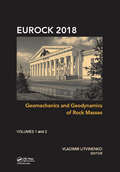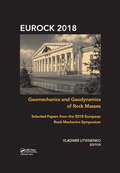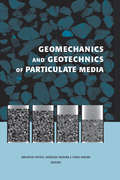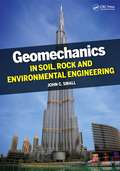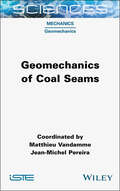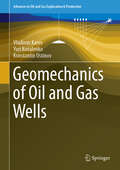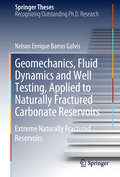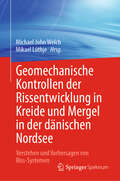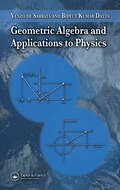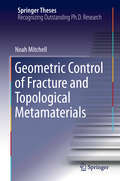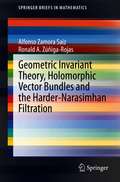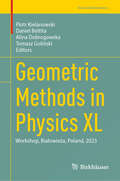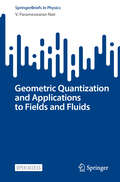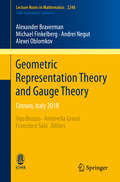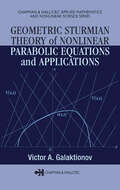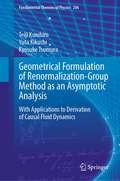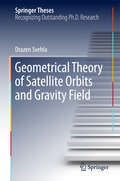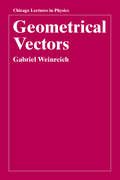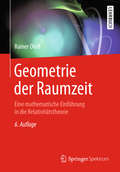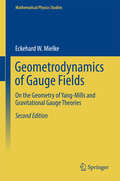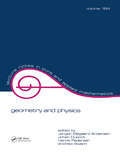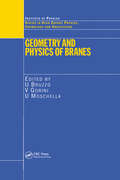- Table View
- List View
Geomechanics and Geodynamics of Rock Masses: Proceedings of the 2018 European Rock Mechanics Symposium
by Vladimir LitvinenkoGeomechanics and Geodynamics of Rock Masses contains contributions presented at EUROCK 2018, the 2018 International Symposium of the International Society for Rock Mechanics (ISRM 2018, Saint Petersburg, Russia, 22-26 May 2018). Dedicated to recent advances and achievements in the fields of geomechanics and geotechnology, the main topics of the book include: - Physical and mechanical properties of fractured rock (laboratory testing and rock properties, field measurements and site investigations)- Geophysics in rock mechanics- Rock mass strength and failure- Nonlinear problems in rock mechanics- Effect of joint water on the behavior of rock foundation- Numerical modeling and back analysis- Mineral resources development: methods and rock mechanics problems- Rock mechanics and underground construction in mining, hydropower industry and civil engineering- Rock mechanics in petroleum engineering- Geodynamics and monitoring of rock mass behavior- Risks and hazards- Geomechanics of technogenic deposits Geomechanics and Geodynamics of Rock Masses will be of interest to researchers and professionals involved in the various branches of rock mechanics and rock engineering. EUROCK 2018, organized by the Saint Petersburg Mining University, is a continuation of the successful series of ISRM symposia in Europe, which began in 1992 in Chester, UK.
Geomechanics and Geodynamics of Rock Masses: Selected Papers from the 2018 European Rock Mechanics Symposium
by Vladimir LitvinenkoGeomechanics and Geodynamics of Rock Masses – Selected Papers contains selected contributions from EUROCK 2018, the 2018 International Symposium of the International Society for Rock Mechanics (ISRM 2018, Saint Petersburg, Russia, 22—26 May 2018). Dedicated to recent advances and achievements in the fields of geomechanics and geotechnology, the book will be of interest to researchers and professionals involved in the various branches of rock mechanics and rock engineering. EUROCK 2018, organized by the Saint Petersburg Mining University, is a continuation of the successful series of ISRM symposia in Europe, which began in 1992 in Chester, UK.
Geomechanics and Geotechnics of Particulate Media: Proceedings of the International Symposium on Geomechanics and Geotechnics of Particulate Media, Ube, Japan, 12-14 September 2006
by Masayuki Hyodo Hidekazu Murata Yukio NakataMicroscopic re-examination of geomaterials consisting of aggregates can shed light on macroscopic behaviour, including compressibility, anisotropy, yielding, creep, cyclic liquefaction and shear rupture. As a result of this process of examination, new methods of material characterization emerge, leading to a greater degree of accuracy in the specification of new constitutive models with physically-meaningful parameters. The impetus behind this development is an increasing awareness on sustainability, leading to the more efficient use of recycled materials for geotechnical applications. The characteristics of recycled materials, such as compressibility and self-hardening, may differ significantly from those of natural materials, and it is crucial that evaluation is made from a specifically particulate perspective.
Geomechanics in Soil, Rock, and Environmental Engineering
by John SmallUtilizes both Computer- and Hand-Based Calculations… Modern practice in geomechanics is becoming increasingly reliant on computer-based software, much of which can be obtained through the Internet. In Geomechanics in Soil, Rock, and Environmental Engineering the application of these numerical techniques is examined not only for soil mechanics, but also for rock mechanics and environmental applications. … For Use in Complex Analysis It deals with the modern analysis of shallow foundations, deep foundations, retaining structures, and excavation and tunneling. In recent years, the environment has become more and more important, and so it also deals with municipal and mining waste and solutions for the disposal and containment of the waste. Many fresh solutions to problems are presented to enable more accurate and advanced designs to be carried out. A Practical Reference for Industry Professionals, This Illuminating Book: Offers a broad range of coverage in soil mechanics, rock mechanics, and environmental engineering Incorporates the author‘s more than 40 years of academic and practical design experience Describes the latest applications that have emerged in the last ten years Supplies references readily available online for futher research Geomechanics in Soil, Rock, and Environmental Engineering should appeal to students in their final undergraduate course in geomechanics or master’s students, and should also serve as a useful reference to practitioners in the field of geomechanics, reflecting the author’s background in both industry and academia.
Geomechanics of Coal Seams (ISTE Invoiced)
by Jean-Michel Pereira Matthieu VandammeGeomechanics of Coal Seams explores the evolving role of coal, transitioning from a historically criticized energy source tied to the Industrial Revolution, to a material with the potential to play a significant role in achieving net-zero greenhouse gas emissions. Traditionally used as raw material, coal now serves as a reservoir for natural gas or carbon dioxide storage, offering a path toward reducing global greenhouse gas emissions. Despite its promise, challenges remain, particularly regarding its geomechanical behavior. This book delves into the unique properties of coal, covering everything from geological foundations to numerical modeling. Aimed at students, researchers, and engineers, the book provides valuable insights applicable to other microporous materials.
Geomechanics of Oil and Gas Wells (Advances in Oil and Gas Exploration & Production)
by Vladimir Karev Yuri Kovalenko Konstantin UstinovThe book presents an integrated approach to studying the geomechanical processes occurring in oil and gas-bearing formations during their development. It discusses the choice of a model that takes into account the basic properties of rocks; experiments to find model parameters; numerical modeling; and direct physical modeling of deformation and filtration processes in reservoir and host rocks. Taking into account features of rock behavior, such as anisotropy of the mechanical properties of rocks during elastoplastic deformation; dependence of permeability on the total stress tensor; the contribution of the filtration flow to the formation stress state; and the influence of tangential as well as normal stresses on the transition to inelastic deformation, it demonstrates how the presented approach allows the practical problems of increasing the productivity of wells, oil recovery, and ensuring the stability of wellbores to be solved.The book is intended for specialists, including geoengineers working in the oil and gas sector, teachers, graduate students and students, as well as all those interested in scientific and technological developments to meet the enormous demand for raw materials and energy.
Geomechanics, Fluid Dynamics and Well Testing, Applied to Naturally Fractured Carbonate Reservoirs
by Nelson Enrique Barros GalvisThis thesis presents an important step towards a deeper understanding of naturally fractured carbonate reservoirs (NFCRs). It demonstrates the various kinds of discontinuities using geological evidence, mathematical kinematics model and computed tomography and uses this as a basis for proposing a new classification for NFCRs. Additionally, this study takes advantage of rock mechanics theory to illustrate how natural fractures can collapse due to fluid flow and pressure changes in the fractured media. The explanations and mathematical modeling developed in this dissertation can be used as diagnostic tools to predict fluid velocity, fluid flow, tectonic fracture collapse, pressure behavior during reservoir depleting, considering stress-sensitive and non-stress-sensitive, with nonlinear terms in the diffusivity equation applied to NFCRs. Furthermore, the book presents the description of real reservoirs with their field data as the principal goal in the mathematical description of the realistic phenomenology of NFCRs.
Geomechanische Kontrollen der Rissentwicklung in Kreide und Mergel in der dänischen Nordsee: Verstehen und Vorhersagen von Riss-Systemen
by Michael John Welch Mikael LüthjeDieses Buch fasst neue Entdeckungen zur Rissbildung in Kreide zusammen. Basierend auf Studien in der dänischen Nordsee zeigt das Buch, wie Beobachtungen von Aufschlussanaloga, Bohrkernen und seismischen Daten genutzt werden können, um die Dichte, Verteilung und Geometrie natürlicher Risse in Kreide und Mergel zu charakterisieren. Laborversuche mit Kreideproben zeigen die Einflussfaktoren auf die geomechanischen Eigenschaften der Kreide und damit auf das Wachstum natürlicher Risse. Schließlich werden verschiedene Modellierungstechniken eingesetzt, um die mechanische Deformation in den Kreide-Strukturen der dänischen Nordsee zu untersuchen und die Rissverteilung sowie -geometrie im Untergrund vorherzusagen. Ein Verständnis der Rissdichte, -verteilung und -geometrie ist entscheidend für die Planung effizienter Strategien zur Fluidextraktion oder -injektion sowie zur CO2-Speicherung. Dieses Buch liefert das notwendige Wissen.
Geometric Algebra and Applications to Physics
by Venzo de Sabbata Bidyut Kumar DattaBringing geometric algebra to the mainstream of physics pedagogy, Geometric Algebra and Applications to Physics not only presents geometric algebra as a discipline within mathematical physics, but the book also shows how geometric algebra can be applied to numerous fundamental problems in physics, especially in experimental situations. This
Geometric Algebra for Physicists
by Chris Doran Anthony LasenbyGeometric algebra is a powerful mathematical language with applications across a range of subjects in physics and engineering. This book is a complete guide to the current state of the subject with early chapters providing a self-contained introduction to geometric algebra. Topics covered include new techniques for handling rotations in arbitrary dimensions, and the links between rotations, bivectors and the structure of the Lie groups. Following chapters extend the concept of a complex analytic function theory to arbitrary dimensions, with applications in quantum theory and electromagnetism. Later chapters cover advanced topics such as non-Euclidean geometry, quantum entanglement, and gauge theories. Applications such as black holes and cosmic strings are also explored. It can be used as a graduate text for courses on the physical applications of geometric algebra and is also suitable for researchers working in the fields of relativity and quantum theory.
Geometric Control of Fracture and Topological Metamaterials (Springer Theses)
by Noah MitchellThis thesis reports a rare combination of experiment and theory on the role of geometry in materials science. It is built on two significant findings: that curvature can be used to guide crack paths in a predictive way, and that protected topological order can exist in amorphous materials. In each, the underlying geometry controls the elastic behavior of quasi-2D materials, enabling the control of crack propagation in elastic sheets and the control of unidirectional waves traveling at the boundary of metamaterials. The thesis examines the consequences of this geometric control in a range of materials spanning many orders of magnitude in length scale, from amorphous macroscopic networks and elastic continua to nanoscale lattices.
Geometric Invariant Theory, Holomorphic Vector Bundles and the Harder-Narasimhan Filtration (SpringerBriefs in Mathematics)
by Alfonso Zamora Saiz Ronald A. Zúñiga-RojasThis book introduces key topics on Geometric Invariant Theory, a technique to obtaining quotients in algebraic geometry with a good set of properties, through various examples. It starts from the classical Hilbert classification of binary forms, advancing to the construction of the moduli space of semistable holomorphic vector bundles, and to Hitchin’s theory on Higgs bundles. The relationship between the notion of stability between algebraic, differential and symplectic geometry settings is also covered.Unstable objects in moduli problems -- a result of the construction of moduli spaces -- get specific attention in this work. The notion of the Harder-Narasimhan filtration as a tool to handle them, and its relationship with GIT quotients, provide instigating new calculations in several problems. Applications include a survey of research results on correspondences between Harder-Narasimhan filtrations with the GIT picture and stratifications of the moduli space of Higgs bundles.Graduate students and researchers who want to approach Geometric Invariant Theory in moduli constructions can greatly benefit from this reading, whose key prerequisites are general courses on algebraic geometry and differential geometry.
Geometric Methods in Physics XL: Workshop, Białowieża, Poland, 2023 (Trends in Mathematics)
by Piotr Kielanowski Daniel Beltita Alina Dobrogowska Tomasz GolińskiThis volume collects papers based on lectures given at the XL Workshop on Geometric Methods in Physics, held in Białowieża, Poland in July 2023. These chapters provide readers an overview of cutting-edge research in infinite-dimensional groups, integrable systems, quantum groups, Lie algebras and their generalizations and a wide variety of other areas. Specific topics include: Yang-Baxter equation The restricted Siegel disc and restricted Grassmannian Geometric and deformation quantization Degenerate integrability Lie algebroids and groupoids Skew braces Geometric Methods in Physics XL will be a valuable resource for mathematicians and physicists interested in recent developments at the intersection of these areas.
Geometric Quantization and Applications to Fields and Fluids (SpringerBriefs in Physics)
by V. Parameswaran NairThis open access book explains geometric quantization from a physicist’s perspective. After presenting the general formalism, it delves into several examples reflecting current research interests in high-energy physics and condensed matter physics. Applications explore Chern-Simons theory, theta vacuum, the Hall effect, fluid dynamics, and elements of noncommutative geometry. The content is tailored to appeal to researchers, graduate students, and advanced undergraduates in high-energy physics, particle physics, and mathematical physics. A background in differential geometry and group theory is beneficial for a comprehensive understanding of the discussions.
Geometric Representation Theory and Gauge Theory: Cetraro, Italy 2018 (Lecture Notes in Mathematics #2248)
by Alexander Braverman Michael Finkelberg Andrei Negut Alexei OblomkovThis book offers a review of the vibrant areas of geometric representation theory and gauge theory, which are characterized by a merging of traditional techniques in representation theory with the use of powerful tools from algebraic geometry, and with strong inputs from physics. The notes are based on lectures delivered at the CIME school "Geometric Representation Theory and Gauge Theory" held in Cetraro, Italy, in June 2018. They comprise three contributions, due to Alexander Braverman and Michael Finkelberg, Andrei Negut, and Alexei Oblomkov, respectively. Braverman and Finkelberg’s notes review the mathematical theory of the Coulomb branch of 3D N=4 quantum gauge theories. The purpose of Negut’s notes is to study moduli spaces of sheaves on a surface, as well as Hecke correspondences between them. Oblomkov's notes concern matrix factorizations and knot homology. This book will appeal to both mathematicians and theoretical physicists and will be a source of inspiration for PhD students and researchers.
Geometric Sturmian Theory of Nonlinear Parabolic Equations and Applications (Chapman & Hall/CRC Applied Mathematics & Nonlinear Science)
by Victor A. GalaktionovUnlike the classical Sturm theorems on the zeros of solutions of second-order ODEs, Sturm's evolution zero set analysis for parabolic PDEs did not attract much attention in the 19th century, and, in fact, it was lost or forgotten for almost a century. Briefly revived by P�lya in the 1930's and rediscovered in part several times since, it was not un
Geometrical Formulation of Renormalization-Group Method as an Asymptotic Analysis: With Applications to Derivation of Causal Fluid Dynamics (Fundamental Theories of Physics #206)
by Teiji Kunihiro Yuta Kikuchi Kyosuke TsumuraThis book presents a comprehensive account of the renormalization-group (RG) method and its extension, the doublet scheme, in a geometrical point of view. It extract long timescale macroscopic/mesoscopic dynamics from microscopic equations in an intuitively understandable way rather than in a mathematically rigorous manner and introduces readers to a mathematically elementary, but useful and widely applicable technique for analyzing asymptotic solutions in mathematical models of nature. The book begins with the basic notion of the RG theory, including its connection with the separation of scales. Then it formulates the RG method as a construction method of envelopes of the naive perturbative solutions containing secular terms, and then demonstrates the formulation in various types of evolution equations. Lastly, it describes successful physical examples, such as stochastic and transport phenomena including second-order relativistic as well as nonrelativistic fluid dynamics with causality and transport phenomena in cold atoms, with extensive numerical expositions of transport coefficients and relaxation times. Requiring only an undergraduate-level understanding of physics and mathematics, the book clearly describes the notions and mathematical techniques with a wealth of examples. It is a unique and can be enlightening resource for readers who feel mystified by renormalization theory in quantum field theory.
Geometrical Theory of Satellite Orbits and Gravity Field (Springer Theses)
by Drazen SvehlaThis book on space geodesy presents pioneering geometrical approaches in the modelling of satellite orbits and gravity field of the Earth, based on the gravity field missions CHAMP, GRACE and GOCE in the LEO orbit. Geometrical approach is also extended to precise positioning in space using multi-GNSS constellations and space geodesy techniques in the realization of the terrestrial and celestial reference frame of the Earth. This book addresses major new developments that were taking place in space geodesy in the last decade, namely the availability of GPS receivers onboard LEO satellites, the multitude of the new GNSS satellite navigation systems, the huge improvement in the accuracy of satellite clocks and the revolution in the determination of the Earth's gravity field with dedicated satellite missions.
Geometrical Vectors (Chicago Lectures in Physics)
by Gabriel WeinreichEvery advanced undergraduate and graduate student of physics must master the concepts of vectors and vector analysis. Yet most books cover this topic by merely repeating the introductory-level treatment based on a limited algebraic or analytic view of the subject.Geometrical Vectors introduces a more sophisticated approach, which not only brings together many loose ends of the traditional treatment, but also leads directly into the practical use of vectors in general curvilinear coordinates by carefully separating those relationships which are topologically invariant from those which are not. Based on the essentially geometric nature of the subject, this approach builds consistently on students' prior knowledge and geometrical intuition. Written in an informal and personal style, Geometrical Vectors provides a handy guide for any student of vector analysis. Clear, carefully constructed line drawings illustrate key points in the text, and problem sets as well as physical examples are provided.
Geometrical methods of mathematical physics
by Bernard F. SchutzIn recent years the methods of modern differential geometry have become of considerable importance in theoretical physics and have found application in relativity and cosmology, high-energy physics and field theory, thermodynamics, fluid dynamics and mechanics. This textbook provides an introduction to these methods - in particular Lie derivatives, Lie groups and differential forms - and covers their extensive applications to theoretical physics. The reader is assumed to have some familiarity with advanced calculus, linear algebra and a little elementary operator theory. The advanced physics undergraduate should therefore find the presentation quite accessible. This account will prove valuable for those with backgrounds in physics and applied mathematics who desire an introduction to the subject. Having studied the book, the reader will be able to comprehend research papers that use this mathematics and follow more advanced pure-mathematical expositions.
Geometrie der Raumzeit: Eine mathematische Einführung in die Relativitätstheorie
by Rainer OloffDie Relativitätstheorie ist in ihren Kernaussagen nicht mehr umstritten, gilt aber noch immer als kompliziert und nur schwer verstehbar. Das liegt unter anderem an dem aufwendigen mathematischen Apparat, der schon zur Formulierung ihrer Ergebnisse und erst recht zum Nachvollziehen der Argumentation notwendig ist. In diesem Lehrbuch werden die mathematischen Grundlagen der Relativitätstheorie systematisch entwickelt, das ist die Differentialgeometrie auf Mannigfaltigkeiten einschließlich Differentiation und Integration. Die Spezielle Relativitätstheorie wird als Tensorrechnung auf den Tangentialräumen dargestellt. Die zentrale Aussage der Allgemeinen Relativitätstheorie ist die Einstein'sche Feldgleichung, die die Krümmung zur Materie in Beziehung setzt. Ausführlich werden die relativistischen Effekte im Sonnensystem einschließlich der Schwarzen Löcher behandelt. Dieser Text richtet sich an Studierende der Physik und der Mathematik und setzt nur Grundkenntnisse aus der klassischen Differential- und Integralrechnung und der Linearen Algebra voraus. Für die neue Auflage wurde das Buch durchgesehen und alle bekannt gewordenen Fehler korrigiert.
Geometrodynamics of Gauge Fields
by Eckehard W. MielkeThis monograph aims to provide a unified, geometrical foundation of gauge theories of elementary particle physics. The underlying geometrical structure is unfolded in a coordinate-free manner via the modern mathematical notions of fibre bundles and exterior forms. Topics such as the dynamics of Yang-Mills theories, instanton solutions and topological invariants are included. By transferring these concepts to local space-time symmetries, generalizations of Einstein's theory of gravity arise in a Riemann-Cartan space with curvature and torsion. It provides the framework in which the (broken) Poincar#65533; gauge theory, the Rainich geometrization of the Einstein-Maxwell system, and higher-dimensional, non-abelian Kaluza-Klein theories are developed. Since the discovery of the Higgs boson, concepts of spontaneous symmetry breaking in gravity have come again into focus, and, in this revised edition, these will be exposed in geometric terms. Quantizing gravity remains an open issue: formulating it as a de Sitter type gauge theory in the spirit of Yang-Mills, some new progress in its topological form is presented. After symmetry breaking, Einstein's standard general relativity with cosmological constant emerges as a classical background. The geometrical structure of BRST quantization with non-propagating topological ghosts is developed in some detail.
Geometrodynamics of Gauge Fields: On the Geometry of Yang-Mills and Gravitational Gauge Theories (Mathematical Physics Studies)
by Eckehard W. MielkeThis monograph aims to provide a unified, geometrical foundation of gauge theories of elementary particle physics. The underlying geometrical structure is unfolded in a coordinate-free manner via the modern mathematical notions of fibre bundles and exterior forms. Topics such as the dynamics of Yang-Mills theories, instanton solutions and topological invariants are included. By transferring these concepts to local space-time symmetries, generalizations of Einstein's theory of gravity arise in a Riemann-Cartan space with curvature and torsion. It provides the framework in which the (broken) Poincaré gauge theory, the Rainich geometrization of the Einstein-Maxwell system, and higher-dimensional, non-abelian Kaluza-Klein theories are developed. Since the discovery of the Higgs boson, concepts of spontaneous symmetry breaking in gravity have come again into focus, and, in this revised edition, these will be exposed in geometric terms. Quantizing gravity remains an open issue: formulating it as a de Sitter type gauge theory in the spirit of Yang-Mills, some new progress in its topological form is presented. After symmetry breaking, Einstein’s standard general relativity with cosmological constant emerges as a classical background. The geometrical structure of BRST quantization with non-propagating topological ghosts is developed in some detail.
Geometry and Physics
by Jørgen Ellegaard Andersen; Johan Dupont; Henrik Pedersen; Andrew Swann"Based on the proceedings of the Special Session on Geometry and Physics held over a six month period at the University of Aarhus, Denmark and on articles from the Summer school held at Odense University, Denmark. Offers new contributions on a host of topics that involve physics, geometry, and topology. Written by more than 50 leading international experts."
Geometry and Physics of Branes
by Ugo BruzzoBranes are solitonic configurations of a string theory that are represented by extended objects in a higher-dimensional space-time. They are essential for a comprehension of the non-perturbative aspects of string theory, in particular, in connection with string dualities. From the mathematical viewpoint, branes are related to several important theo
